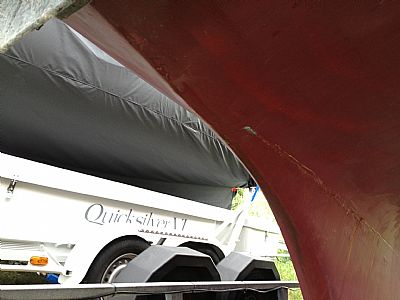The Waterline Controversy
Pedersen & Thuesen Dragons gained a reputation for speed, beauty and strength of construction. By 1962 they had won Cowes Week, the Edinburgh Cup, an Olympic Gold medal, the European Championships and the Gold Cup, as well as several national championships. The other Dragon boat builders started to mutter about unfair advantages and the nascent International Dragon Association had to step in to rule on the eligibility of Pedersen & Thuesen as well as other yards Dragons in 1962, its first year as the official class body.
As ever, there are two sides to the story and over the years some embellishment is bound to have occurred. One side is that Borresen’s, the other renowned Danish builder of Dragons and based just up the road at Vejle, initiated a rumour amongst the racing fraternity that Pedersen & Thuesen Dragons were built with a longer waterline and a finer entry at the front of the keel, thus giving them extra speed and an unfair advantage. Pedersen & Thuesen rejoined that the way in which they measured their hulls was the same as most of the then active Dragon yacht builders; the length from station 8 measured forward added to the length from station 8 measured toward the stern, inclusive of the maximum tolerances allowed by the rules. Besides, they argued, the Pedersen & Thuesen Dragon tended to be bought by the better sailors and thus won most races. It was also argued by some that Bjarne Aas, another well regarded builder of Dragons from Fredrikstad in Norway, also made longer waterline boats. It may well be that the sheerline was marginally straighter than other builders boats, yet still within the tolerances allowed at that time. Other racers were not convinced that there was any significant differences between the Borresen or Pedersen & Thuesen built Dragons; some were quick straight from the yard, others not quite so.
Whatever the minutiae of the various arguments doing the rounds amongst Dragon racers in the early 1960s, the newly formed IDA felt it needed to step in and to be seen to do something positive for the class. In 1963 they ‘grandfathered’ all Dragons built up until then and also issued re-drawn templates which went all the way around the hull, though no actual measurements or tolerances were changed, with the exception of the front edge of the keel, for which a new template was issued.
Bringing the story more up to date, during 2014 there were again mutterings amongst the international Dragon racing fraternity. This was due to the increasing number of restored Pedersen & Thuesen Dragons re-appearing on the circuit and starting to make some respectable results. Indeed, Debutant, a 1960 boat, won the Europeans with Lars Hendriksen at the helm. Six Pedersen & Thuesen Dragons were gathered together in Denmark to be remeasured alongside each other. Not only did they measure successfully within the current rules, but also within the rules of the time they were built; some of them were found to be over the weight limit! So they were deemed to be racing within the measurement rules. The fact that most of these boats are owned by people able to afford the best restoration, rigging, sails and crews and to be campaigned at high profile events is actually the reason that they continue to be successful.
Furthermore, in 2017, whilst researching and developing their then new v6 Dragon hull shape, Petticrows had access to several beautiful, fast P & T Dragons, allowing them to investigate the properties of the hulls to better understand their renowned boat speed. They were able to use the services of a world expert in photogrammetric scanning who carried out a series of scans, which were then overlaid onto the existing Petticrow hull shape. The data obtained was then passed onto expert boat designer Phil Morrison who was able to create the shape for a new hull mould. This lead to the creation of the v6 Petticrows Dragon. In effect, the renowned properties of the P & T hull, from 50 years ago, have been utilised to help produce what is acknowledged as being one of the Petticrows yard's fastest Dragon hull design.

The forward edge of the keel area that was controversial - allegedly!

